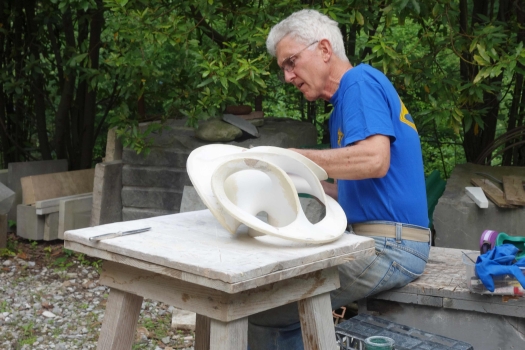
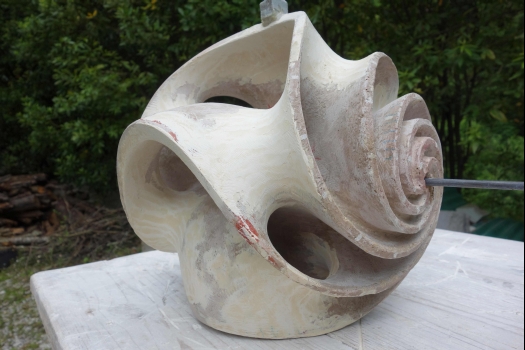
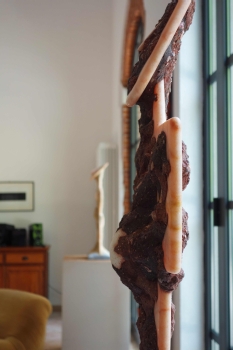
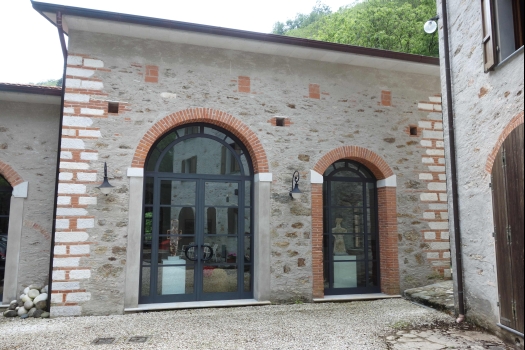
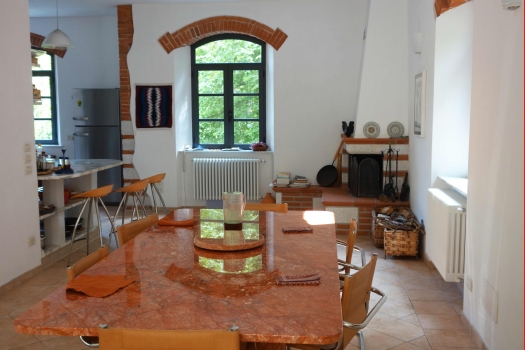
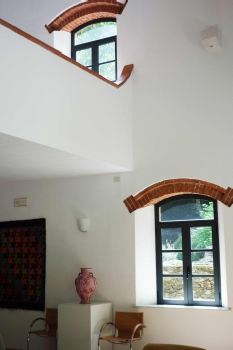
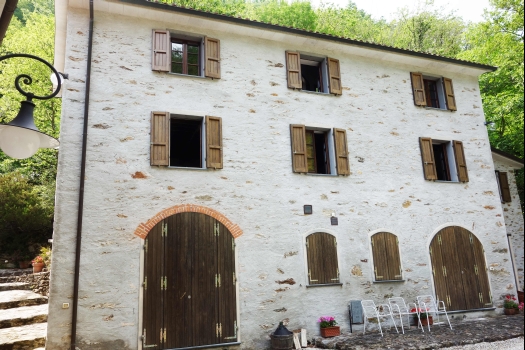
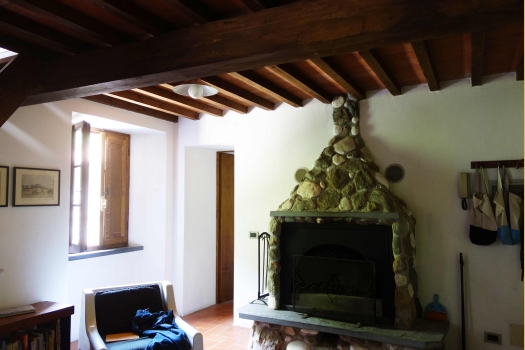
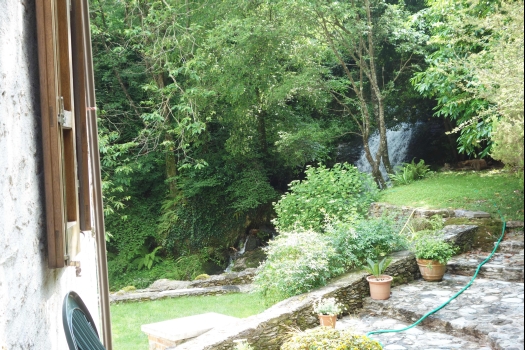
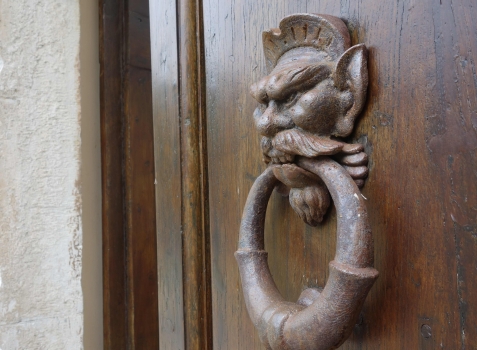
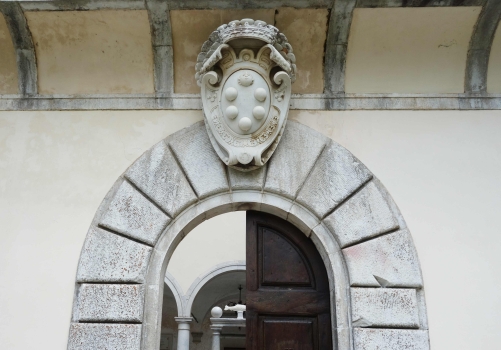
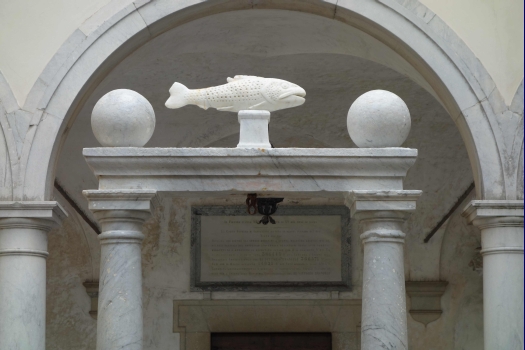
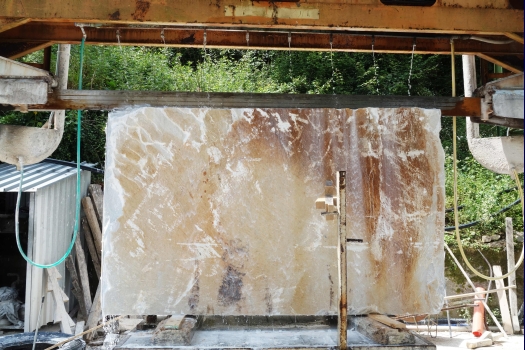
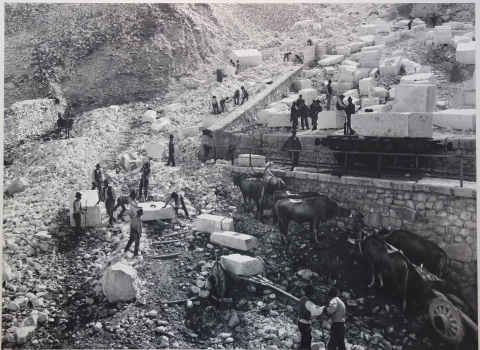
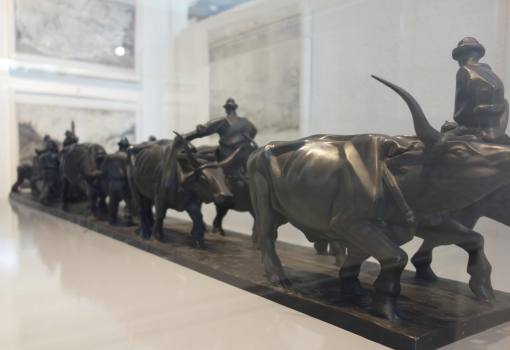
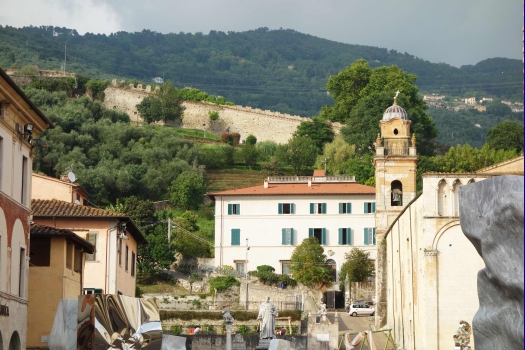
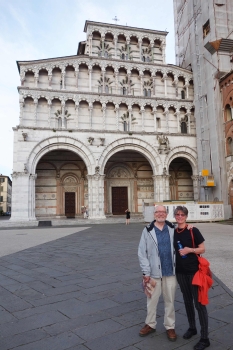
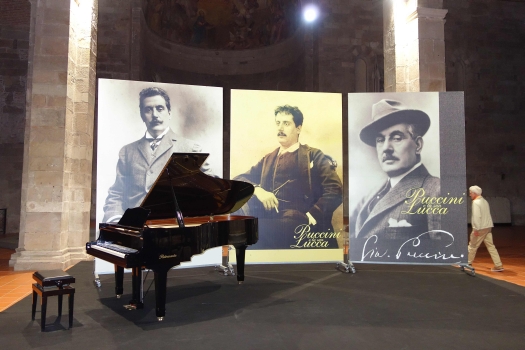

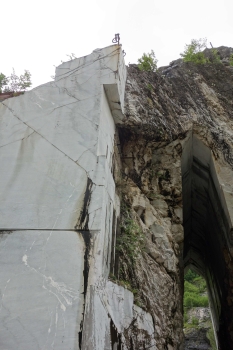
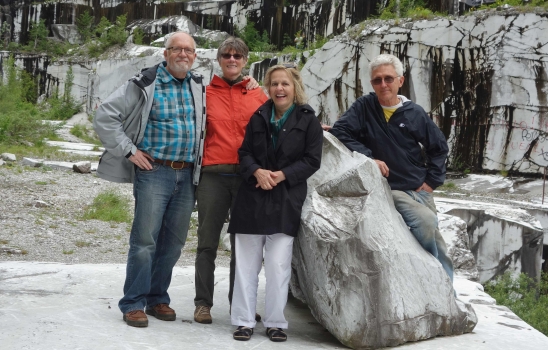
We're just back from two weeks in Italy. It seemed like two separate trips - one to visit our friends Mary and Craig in Seravezza, another to gorge on the Renaissance wonders of Florence and Rome. We flew into Pisa and drove north to Versilia and then east into the mountains of Tuscany. Mary and Craig live for part of the year in a stunning house renovated by Craig up a heart-stoppingly narrow and winding road from Seravezza. There is a river flowing through the property, including a real live waterfall, so the chuckling of running water is always there. It tends to be more cloudy in the mountains than on the coast and noticeably cooler. There was also some rain during several of the days we were there, although never enough to spoil our plans.
This area of Tuscany, although gorgeous, is not a huge tourist attraction. Instead, for many years, one of the main industries has been the extraction of marble from the mountains. At the beginning of the 16th century, Michelangelo was sent to develop the Tuscan marble deposit and spent several years supervising the building of roads so that the workers could get to the marble quarries and the blocks of marble could be transported off the mountain for further processing. The process of cutting the blocks of marble out of the mountain has evolved over the years and is now accomplished by setting up a network of pulleys over which a cable runs in a loop. The cable used to do the cutting by having sandy water constantly poured over it; it now has diamond cutters attached to it.
The blocks used to be moved down the steep slopes on a sled until they could be put on a cart pulled by oxen. The cart would take the blocks to the town where they were classified according to suitability for various end uses. Softer marble with little veining could be carved by sculptors; harder marble might be used for construction. We even discovered that the remnants could be ground up and used in toothpaste, since the grains are abrasive but still softer than tooth enamel.
I was interested to learn that sculptors don't carve marble much any more; instead, they carve the object in some other medium like plaster, which is easier and more forgiving to work with. Then they visit Mr. Robot who scans the piece and duplicates it in marble. The sculptor then takes over for the fine finishing and assembly. Just think what Michelangelo could have done with that! We visited the workshop of two of Craig's sculptor friends, Cynthia Sah and Nicolas Bertoux; you can see a video of how they created a recent piece at: https://www.youtube.com/watch?v=S92AxlYZ51w
While staying with Craig and Mary, we accomplished the following:
During our time with Mary and Craig, we all drove over to Florence. Cars are not permitted in the center of town, where our hotel was, except for special purposes, such as dropping off our bags at the hotel. We had to let the city know our licence plate in advance, so the police would know to let us pass; once we had dropped off our bags, a driver from the city hopped into our rental car and drove it we know not where. At the end of our stay, the city was informed that we were leaving and our car magically appeared once more at our hotel.
At Mary and Craig's urging, we reserved ticket time-slots for the major galleries online. If you don't do this, you get to stand possibly hours in line waiting for your turn. So we felt like VIPs, being whisked in ahead of the unwashed masses. If we had not known to do this, our experience would have been much less pleasant.
Our first stop was the Duomo museum, which contains a lot of the statues, original doors and other decoration from the facade of the Duomo after the decision was made to rip the facade off. Then the Accademia where we were most interested in seeing Michelangelo's David, which is not only a huge attraction but also just plain huge - 17 feet tall. (One case where photos can be quite misleading.) We felt exhausted by our museum-going and spent the afternoon wandering around the city from one gelateria to the next. Florence is stuffed full of tourists and we sometimes felt like we were in Disneyland.
The next day was the Uffizi, which means office building, although like no office building I ever saw. It is one of the most amazing art museums anywhere; the corridors have wonderfully painted ceilings (and I'm not talking Sherwin Williams here), and the collection of world-famous Renaissance art boggles the mind. By the time we finished, we dragged our tired bones over the Ponte Veccio and had a most welcome lunch.
After lunch, we went to Volterra, between Pisa and Florence. Woe to the attackers trying to sack and pillage it - the town is perched on the top of a high hill, enclosed by walls, and with automobile access only via a series of switch-backs. A couple of the features of the town go back to the Etruscans who were the dominant fellows in these parts between 700 BC and 400 BC, before the Romans took over. We went around the local Etruscan museum and saw that their sculpture and pottery looked to be quite as advanced as that of the Romans. Many of the artifacts in the museum were small marble boxes for containing the ashes of the dead. Volterra also is a center for sculpting alabaster into objects suitable for the tourists - we picked up a nice bowl and a mortar and pestle. We spent the night at a converted convent, complete with cloisters and bell tower.
On June 15, we said goodbye to Mary and Craig and thanked them for being such good friends and fine hosts. We drove back down the winding skinny road to Seravezza, to Versilia and back to the Pisa airport to drop off the rental car. We then took a taxi, first to the famous tower, where we snapped some mandatory photos, and then to the train station. There was a fast train to Rome, but we would have had to change trains in Florence and it would have run about 100 Euros each, so we decided to take a local that took us all the way to Rome, took an extra hour but only cost about 25 Euros each. It was clean and pleasant and we had the pleasure of watching the scenery rather than a 200 kph blurr, although as we came into Rome, we started seeing American-style gang chops from the 1970ies - some even plastered on the outside of a train.
Our B&B was conveniently situated on the Tiber, not far from the Vatican. After we checked in, we strolled to the Castel Sant'Angelo, where I imagined Tosca leaping to her death. The bridge over the Tiber leading to the Castel is lined with Bernini statues. How cool is that?!
The next day we had booked a guided tour of the Vatican museums so we arose early, walked to the entrance of the Vatican and met up with our group. The guide turned out to have an inexhaustible supply of amusing anecdotes about the artists, relating to their work, their personal hygeine and personality clashes with other arists and clerics of the day. She also was indispensable, since there are five km of corridors in the museums and without her we would probably died of thirst in some forgotten corner. She gave us the Greatest Hits and kept us trotting along at a good pace. The cherry on top, of course, was the Sistine Chapel, where we found ourselves at the end of the tour. Guides are not allowed in the chapel. Hats are not allowed in the chapel. Talking is not allowed in the chapel. There is no photography in the chapel. Tourists must keep moving at all times in the chapel. Gards are on hand to enforce all these strictures. All this sounds a little bit harsh, but I have some sympathy with the logistical problems the pope must face, given the enormous throngs of tourists who would like to linger there all day.
Before we entered, we got a juicy story from our guide, relating to the huge painting of Judgment Day by Michelangelo that covers one of the walls. There was some controversy over the fact that many of the figures were unclothed and quite a few of them full frontal. Clerical objections were made on the grounds of indecency, although these objections came to nothing for many years. After Michelangelo's death, however, the pope agreed that something should be done about it if it could be done tastefully. Therefore he commissioned another artist to return to the worst offenders and ... add underpants to obscure the genitalia! The underpants persisted until the recent restoration, which then raised the question of whether the underpants should remain or should be removed to restore Michelangelo's original version. Although it was planned to restore Michelangelo's original version, it was found that in some cases the original paint underneath had been scraped off, so some of the underpants have survived the restoration.
The chapel itself is freshly renovated and the colors are incredibly vibrant. But we faced a problem I had not anticipated - the chapel is huge, about 50 feet high. I had imagined something the size of my living room, where I could study each panel closely. But when I looked up at the ceiling, I could hardly see the famous Creation of Adam. I guess it was there and I know that it is incredible, but I'd appreciate it much more looking at a reproduction of it.
After the tour, we needed a rest and so walked to the Castel Sant'Angelo bridge where you could take a ride on a boat, and spent most of the afternoon buzzing up and down the Tiber.
Last day in Italy, alas! We had an early reservation at the Borghese Gallery, which turned out to be our best experience yet - not too crowded, not too big but full of kick-ass art. The ones we liked the most were Bernini's David (concentrating intently on landing a good shot on Gollaith) and his Apollo and Daphne, caught in the moment of her transformation into a tree. There is also a sculpture of Napoleon's sister Pauline, who was known for her capriciousness and promiscuity. While she was married to Prince Camillo Borghese, he commisioned the sculpture to depict her as the chaste goddess Diana, but Pauline insisted that she be shown mostly nude, to the dismay of the rest of the family. When asked whether she was not uncomfortable being naked in the room with the artist, Pauline replied, “Ah, but there was a fire in the room.” After finishing the Gallery, we strolled around the grounds and then took a cab to the Colosseum. We didn't have advance-purchase tickets and so we didn't tour the inside, but it is still pretty impressive on the outside. Nearby is the Arch of Constantine and the Forum, which is a large area of Roman ruins still being excavated to this day.
Then to Piazza Navona, a hot tourist destination; our cab driver warned us not to dine there because the prices are ridiculous. But we were hungry, so we went into a restaurant anyway. Then we saw the menu and ran screaming back into the Piazza. But across from where we were was a pizzeria which served me a really good four-cheese pizza for a not-unreasonable price. We sat for a while, admiring the piazza (as well as the pizza) and feeling like it had been a really special vacation.
Louise and I did not book our flights simultaneously, so Louise ended up having to take a somewhat more circuitous route via Paris. My flight to JFK went OK, but then I had to spend an eternity waiting for immigration (not the TSA). After that, I had to take a bus to another terminal and ended up making my connection to Austin by a whisker. Louise had it worse, however - her flight out of Rome was delayed so she could not make her connection in Paris. The airline paid for a hotel and a meal, but it was a miserable experience and she didn't get back to Austin until 4 pm the following day.
Copyright © 2016 by Peter Lloyd-Davies. All rights reserved. Privacy Statement.